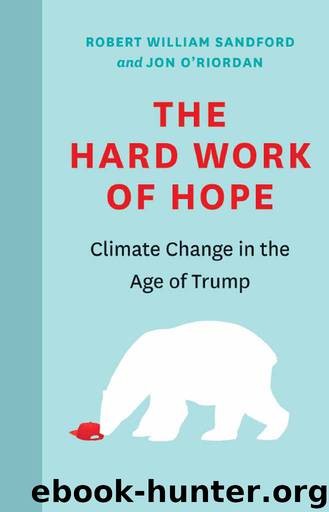The Hard Work of Hope by Robert William Sandford

Author:Robert William Sandford
Language: eng
Format: epub
Publisher: RMB | Rocky Mountain Books
Published: 2017-04-07T04:00:00+00:00
INCREASING CARBON STORAGE IN NATURAL ECOSYSTEMS
The foundation for the low-carbon, resilience approach is the integration of carbon-reduction measures with restoration of natural capital in order to buffer the impacts of increasingly frequent and intense extreme-weather events. “Natural capital” is the term applied to ecosystems that provide a range of “goods” essentially free of charge, such as water for drinking, irrigation, flood control and recreation. This natural capital also provides “services,” such as carbon sequestration, soils, water filtration, drought protection and aesthetic values. Both of these sets of goods and services have been undermined due to poor land use, deforestation, rapid urbanization and the general failure to value natural capital in making decisions on resource development. As a result, less than 25 per cent of global carbon emissions are currently stored in forests and other natural ecosystems, well short of the target of 50 per cent.
An Obama White House report called United States Mid-Century Strategy for Deep Decarbonization estimated that the natural capital of the US could store between 30 and 50 per cent of the nation’s carbon emissions through increasing the extent of forests on public lands by between 16.2 and 20.2 million hectares; improving forest management; protecting and restoring wetlands; and reducing the risk of forest fires and other natural disturbances.
Another key strategy is to restore carbon in agricultural soils. The UN Food and Agriculture Organisation estimates that if the pace of soil degradation continues, all of the world’s topsoil could be gone in 60 years. More than a third of this precious resource has already been lost to industrial agriculture, deforestation and use of heavy equipment. Improved soil management can be achieved through application of agro-ecology principles – planting nitrogen-fixing crops; protecting soil by limiting tillage; precise application of fertilizer to reduce waste; and development of heat-tolerant crops. Such measures could increase carbon sequestration by a further 10 per cent. Scientists at World Agroforestry Centres in China, Kenya and Indonesia and at the Royal Botanic Garden in Edinburgh, Scotland, now estimate that agricultural lands properly managed under agro-ecology principles can hold four times the amount of carbon than originally thought by the IPCC.
An independent group of experts undertook a detailed analysis on how current industrial agriculture might transition to agro-ecology in a 2016 report titled From Uniformity to Diversity: A Paradigm Shift from Industrial Agriculture to Diversified Agroecological Systems. The shift includes significant additional merits such as improving crop nutrition, with resulting benefits for public health; soils management and increased carbon sequestration; reduced water applications and more efficient energy use; and improvements in food security by focusing on regional production rather than food imports. An additional policy area affected includes changes in agricultural subsidies. Globally, countries spend US$560-billion a year on supporting excessive fertilizer use, resulting in pollution of streams and lakes and encouraging massive drainage schemes that increase flooding of adjacent lands. In developing countries, women make up the bulk of small farmers, yet they currently have no access to financing. Improvements in real-time monitoring and better science will build capacity for new entrants to agro-ecology to help achieve these transformations.
Download
This site does not store any files on its server. We only index and link to content provided by other sites. Please contact the content providers to delete copyright contents if any and email us, we'll remove relevant links or contents immediately.
| Anthropology | Archaeology |
| Philosophy | Politics & Government |
| Social Sciences | Sociology |
| Women's Studies |
The Secret History by Donna Tartt(18160)
The Social Justice Warrior Handbook by Lisa De Pasquale(11952)
Thirteen Reasons Why by Jay Asher(8451)
This Is How You Lose Her by Junot Diaz(6438)
Weapons of Math Destruction by Cathy O'Neil(5829)
Zero to One by Peter Thiel(5489)
Beartown by Fredrik Backman(5357)
The Myth of the Strong Leader by Archie Brown(5238)
The Fire Next Time by James Baldwin(5016)
How Democracies Die by Steven Levitsky & Daniel Ziblatt(4958)
Promise Me, Dad by Joe Biden(4908)
Stone's Rules by Roger Stone(4857)
100 Deadly Skills by Clint Emerson(4691)
A Higher Loyalty: Truth, Lies, and Leadership by James Comey(4550)
Rise and Kill First by Ronen Bergman(4545)
Secrecy World by Jake Bernstein(4388)
The David Icke Guide to the Global Conspiracy (and how to end it) by David Icke(4380)
The Farm by Tom Rob Smith(4323)
The Doomsday Machine by Daniel Ellsberg(4245)
